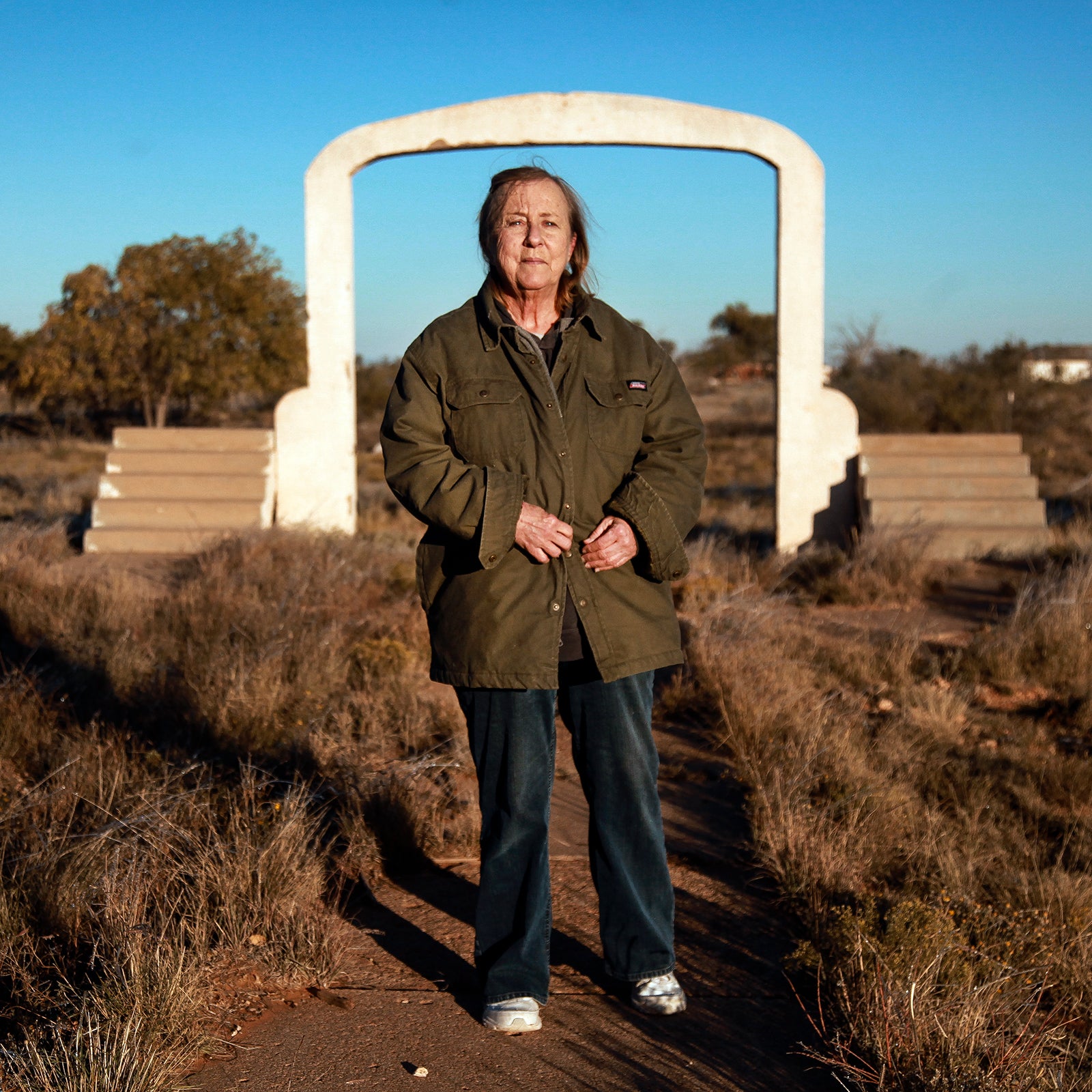Inside a refurbished schoolhouse in a ghost town on New Mexico’s rural eastern plains, Debra Dawson sits on the side of her bed. “Some people call me a crazy cat lady,” she says, motioning toward the pile of kittens cuddling on her bedspread. “I don’t care. Living out here can be lonely, and they are a good company.”
Company in the town, named Yeso, is indeed hard to come by. Dawson, 65, is the only person who lives among its crumbling structures (though two other people live in houses on the highway going through town and are technically also residents). Yeso was once a burgeoning railroad stop, but over the past 70-odd years, its inhabitants slowly abandoned it. It was deserted decades before Dawson moved here with her then husband. She is one of just a handful of people known to permanently live in the ruins of the many ghost towns sprinkled across the West’s high plains.
“Hard to imagine 300 families here,” Dawson says, walking through one of Yeso’s collapsing adobe neighborhoods, shadowed by her dogs, Duchess and Missy. Dawson has bright blue eyes and shoulder-length blond hair that she wears tied back. She is sporting an Army green jacket that conceals a well-used Pink Floyd Dark Side of the Moon hoodie. It’s an unseasonably cold day in October, and a fog has settled on the landscape, coating the mesquite, sagebrush cacti, and grasses in dew. As the weather grows colder, the air freezes, leaving the plants covered in tiny icicles that reflect the afternoon sun and vibrate in the steady wind. “If it’s windy anywhere in New Mexico, it’s windy here,” says Dawson. “But it sure is pretty.”
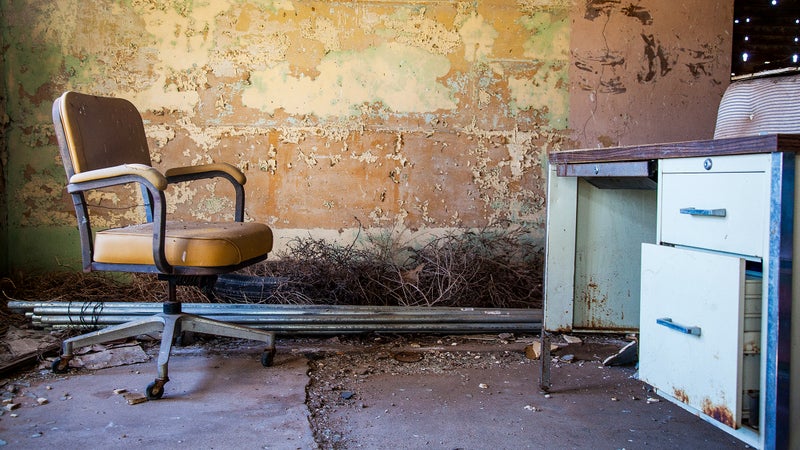
On our walk around town, we pass by dozens of buildings in various states of decay: a peeling wood-framed dance hall, the gutted Super Service Drive-In Garage, and a dilapidated three-story hotel with a faded sign that reads “Mesa Hotel—Rooms 75 cents to a Dollar.” According to John Mulhouse, the founder of a ghost-town documentation project called , “Yeso is intact. Not much has been torn down or lost. It feels charming in a way that abandoned places don’t always feel.”
When we arrive back at Dawson’s home, we examine the plastered adobe arch outside her schoolhouse, where children would line up (girls to one side, boys on the other) to catch the bus a century ago. “I would have loved to go back and see what it was like then,” Dawson says. “It’s an odd and interesting thing to be surrounded by the memories of the past.”
Yeso was first established in 1906 when the Belen Cutoff—a new section of the Santa Fe Railroad—was built, along with a train depot. But the switch from coal to diesel engines during the 1930s necessitated fewer railroad stops, and the general postwar downturn in train travel eventually led Yeso’s inhabitants to leave it for larger towns and cities. The area became a victim of the broader forces of rural decline that have left enumerable communities across the country emptied or reduced to shadows of their former selves. “These towns are everywhere,” says Mulhouse. “This is lost Americana.”
Dawson and her former husband arrived in Yeso in the late 1980s. The couple moved from a silver-mining ghost town in Idaho, where they had lived in an abandoned storage facility. According to Dawson, ghost towns were always her ex-husband’s passion. He relished the isolation, the abandonment, and, above all, the absence of neighbors. “He didn’t do well with others,” she says.
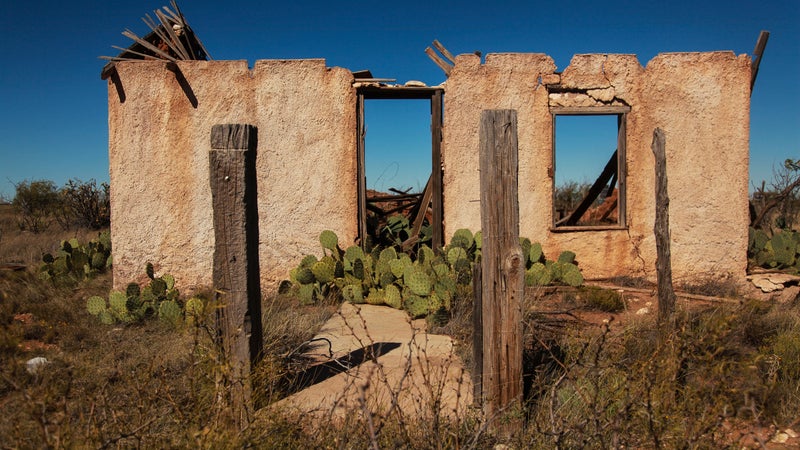
The Idaho town was a bit too cloistered though, at least for Dawson. “It snowed June first and didn’t stop till May,” she says, recalling the brutally cold winters. “Being cooped up in a house, that was too much for me.” On their way to Florida following the death of Dawson’s mother in 1988, the couple happened to drive by Yeso and were immediately attracted to the town. Dawson loved the expansive plains of eastern New Mexico, the quiet, and the remains of the charming old WPA-era buildings located on this lonely stretch of Highway 60. It was 22 miles from the nearest town, Fort Sumner. The weather was better, too.
Dawson and her husband spontaneously decided to put down roots in Yeso. They moved into a brick house on the main road and began the arduous process of remodeling the nearby school, which they purchased for $10,000. When Dawson divorced her husband some years later, he left, and she stayed. “He took the cars,” says Dawson, referring to the 35 custom vehicles—mostly Buicks—that he kept in a large garage connected to the school. “I got the house.”
Dawson has lived by herself ever since, getting by on Social Security checks. She drives herself to Fort Sumner twice a week for church and groceries and is close friends with one of her neighbors on the highway who checks on her every day and takes her into town when the roads are icy. (The only significant way that COVID-19 has changed Dawson’s life is that her church has closed its doors—this April was only the second time since 1961 that she’s missed an Easter service.)
As the years passed, Dawson became increasingly interested in Yeso’s history and the small details of community life that define a place but are often lost when towns are abandoned. So she went to the library in Fort Sumner to research the WPA’s impact on Yeso after the Great Depression and talked to former residents and others in the region who knew its history. “It was a poor town but a real community,” Dawson says, motioning to a tiny house, the smallest one still standing, where a family of 15 once lived.
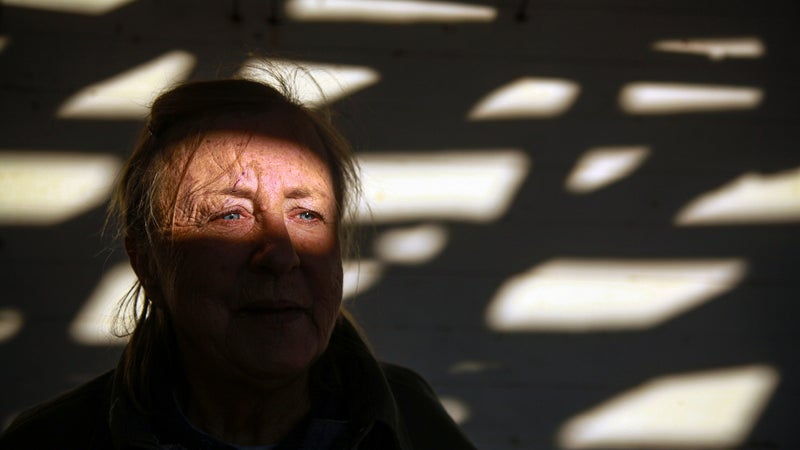
Years back she met the youngest of the 12 children who once crammed into the adobe structure. “I was told that when it was nice out, the boys would sleep under the stars,” Dawson says. That woman, who died in in the 1990s, recounted other stories of life in Yeso. “If one person had meat, they’d pass it out so that everyone had it,” Dawson says. “She told me that every house would have a pot of beans and fresh tortillas going. After school the kids could stop in at any house and eat.”
Dawson acknowledges that some might find it odd that she chooses to live surrounded by the memories of a more vibrant past. “People in Fort Sumner ask me that often,” she says. Her answer is simple: “I love it.” Life in Yeso suits her, she says. She has her faith, her small community, and her animals.
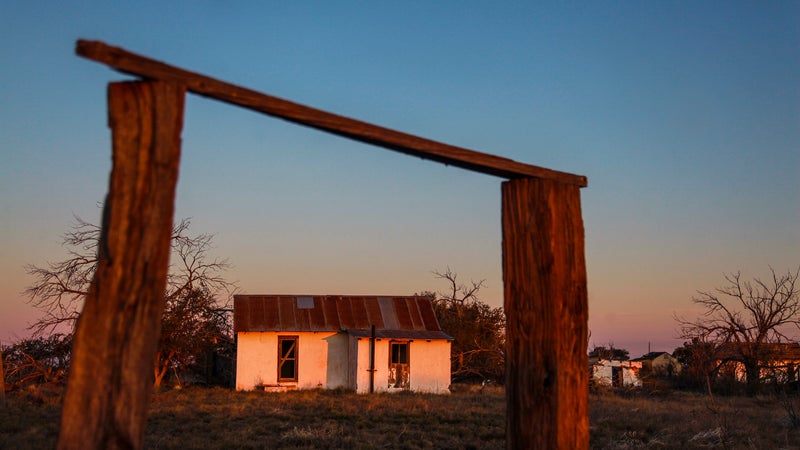
In the years since her husband left, her home has become something of a de facto animal shelter. “A lifelong dream,” as Dawson describes it. “As long as I can remember, I have had a connection with animals.” She says that during her 30 years living in Yeso, she has rescued and found new homes for more than 50 cats and dogs, many with rough pasts like hers. It’s gotten to the point where people in Fort Sumner will frequently call her to tell her about a stray that needs a home. Other times animals will just show up. “This one was tied to my gate,” she says, motioning to Duchess, who is sitting on her feet.
Even for Dawson, though, it can be tough to watch the continual decay of the place she calls home. For instance, the old Catholic church in town has now lost its roof and the walls are beginning to go. “I contacted the local archdiocese to see if they would fix up,” she says. “They said no. It is sad to see these places just deteriorate.”
While it has been nearly 70 years since the last Yeso student walked through the doors of the old schoolhouse, Dawson has filled the space with life. “It’s why God put me here,” she says, back inside her warm house, surrounded by cats. “I would not have it any other way.”


